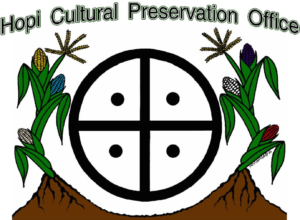
MISSION/FUNCTION:
State of Purpose: The Hopi Cultural Preservation Office (HCPO) is charged with the responsibility of representing the Hopi peoples’ cultural interest both within and outside the Hopi reservation including the newly acquired lands (ranches). The responsibility requires the involvement and the input of the Hopi villages, clans, and religious societies as well as the Hopi tribal government. The Hopi Cultural Preservation Office is the central tribal clearing house for the culturally related issues coming to the attention of the Hopi Tribe.
Traditional Knowledge
As with all Native American cultures, traditional knowledge is central to Hopi culture. There is no more rewarding method of learning than the original “interactive method,” speaking and listening. For the Hopi, traditional knowledge explains not only the origin of all peoples but provides lessons for how to live today.
Multi-level learning
Most of us know at least one children’s fairy tale that has a moral lesson in it. Although the story is meant to be entertaining, it is also supposed to be educational. Hopi traditional knowledge is encoded in this way and contains messages on many different levels. In this way, listeners learn new and important lessons as their own understanding deepens. The strength of traditional knowledge lies in its ability to convey a deeper truth. Seen in this light, traditional knowledge is more than just the retelling of events, names, and dates. In this way, traditional knowledge differs from written historical accounts in style and purpose.
Archaeology
Archaeological Resources Preservation Act 1979
HCPO Archaeological Cultural Resources Monitoring Fieldwork
HCPO Archaeological Cultural Resources Survey
HCPO Cultural Resources Inventory Request Form
Intellectual Property Rights
In this information age, we are concerned with protecting our own ideas. These ideas may be in speeches, music composition, computer programs, television, and other media. Our nation’s courtrooms are filled with cases in which someone allegedly breached that intellectual property right.
Through the decades the intellectual property rights of Hopi have been violated for the benefit of many other, non-Hopi people that has proven to be detrimental. Expropriation comes in many forms. For example, numerous stories told to strangers have been published in books without the storytellers’ permission. After non-Hopis saw ceremonial dances, tape recorded copies of music were sold to outside sources. Clothing items of ceremonial dancers have been photographed without the dancers’ permission and sold. Choreography from ceremonial dances has been copied and performed in non-sacred settings. Even the pictures of the ceremonies have been included in books without written permission. Designs from skilled Hopi potters have been duplicated by non-Hopis. Katsinas dolls have also been duplicated from Hopi dancers seen at Hopi. Although the Hopi believe the ceremonies are intended for the benefit of all people, they also believe benefits only result when ceremonies are properly performed and protected.
All of these actions are breaches of Hopi intellectual property rights, used by non-Hopi for personal and commercial benefit without Hopi permission.
Through these thefts, sacred rituals have been exposed to others out of context and without Hopi permission. Some of this information has reached individuals for whom it was not intended (e.g., Hopi youth, members of other clans, or non-Hopi).
Please be mindful of the personal ethics involved in and laws surrounding this issue.
